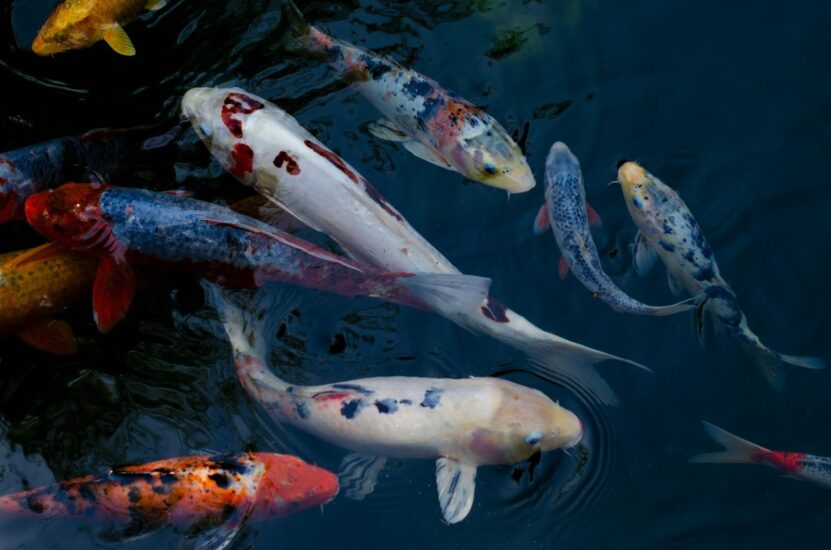Pond fish need care that shifts with the seasons. Water temperature, sunlight, and weather patterns directly influence their health and behavior.
Adapting care routines helps avoid illness, encourages proper feeding, and promotes a stable environment.
Seasonal awareness supports vibrant, thriving fish and a well-balanced pond year-round.
Pond Fish Needs Throughout the Year

Pond fish are highly sensitive to temperature changes. Every seasonal shift brings physiological responses that demand attention.
These fluctuations impact energy use, feeding routines, immune function, and overall behavior.
Seasonal changes do not just alter how fish eat. They affect how they swim, interact, hide, and even how well they fight off disease.
Warmer water increases activity but also raises oxygen demand. Colder water limits movement, suppresses digestion, and dampens immune responses.
Each season creates a new set of care expectations:
- Spring: As fish awaken from dormancy, their energy returns faster than their immunity. They may appear active but remain vulnerable to infections.
- Summer: Metabolism peaks, leading to increased appetite and active swimming. Filtration systems must keep up with higher waste output.
- Autumn: Gradual cooling signals reduced feeding. Fish begin storing energy and slowing down as daylight shortens.
- Winter: Fish enter a near-dormant state. Feeding stops, and movement slows to preserve energy stored in body fat.
Feeding, cleaning, and monitoring must be adjusted as these phases unfold. No single routine fits all seasons.
Observing fish behavior, water temperature, and environmental cues provides the most reliable guide to daily care.
Now we will learn about each season in greater detail.
Spring: Awakening from Winter Dormancy
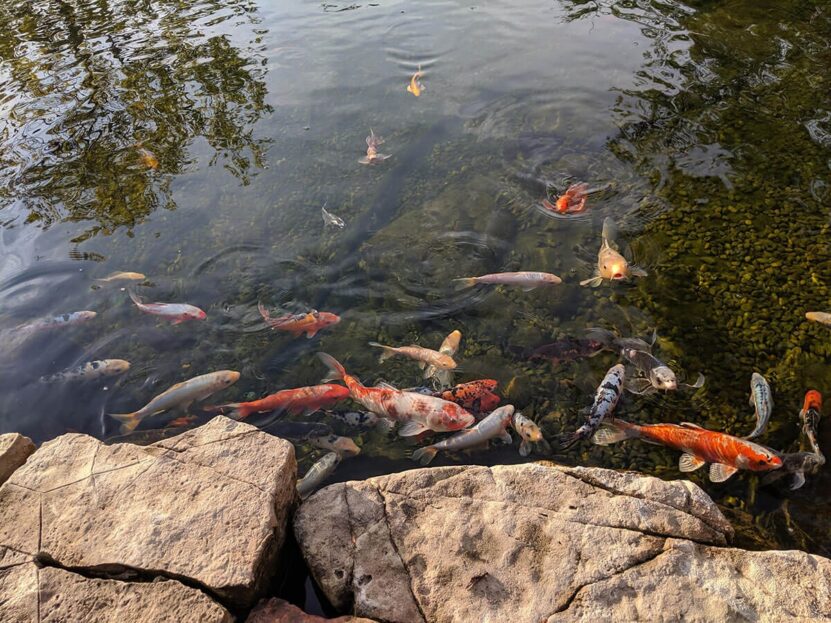
Warmer water signals the return of activity for pond fish. As temperatures climb, their internal systems begin shifting away from the winter mode dominated by cold-weather isoenzymes.
Regular metabolic processes take over, but that transition takes time.
Immunity doesn’t bounce back overnight. Fish may swim more, but they remain vulnerable to infections and parasites due to lagging immune function. That early energy surge often gives a false impression of full recovery.
Signs of Stress or Illness
Pay attention to any behavioral or physical signs that something is off. Early spring brings a higher risk of disease outbreaks, so detection must be prompt. Indicators include:
- Clamped fins held close to the body
- Red patches or streaks on the skin or around the gills
- Lethargy or isolating behavior
- Decaying or frayed fins
Act quickly if symptoms appear. Spring is a fragile period, and small issues can escalate fast.
Spring Cleaning & Pond Prep
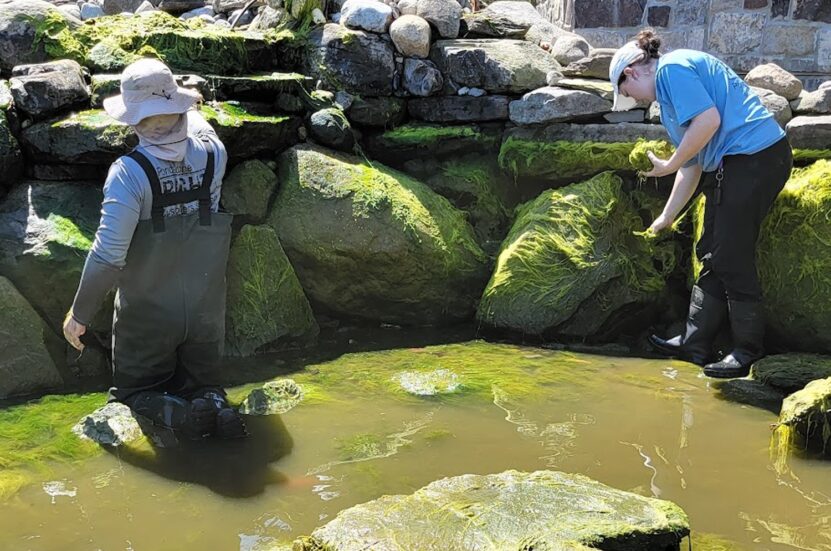
Start by clearing out any leftover winter debris. Dead leaves, organic sludge, and uneaten food should all be removed.
Vacuum the pond bottom if sludge buildup is visible. Rinse and clean filters without killing beneficial bacteria, and perform partial water changes if parameters are out of balance.
Some keepers use pond salt as a tonic to reduce stress and support healing. However, salt should be added cautiously and only after confirming it won’t interfere with plants or biological filtration.
If you want to learn about the tools you can use to maintain the water clarity, visit this site.
Feeding Resumption
Fish coming out of dormancy cannot digest high-protein food immediately.
Start with small portions of easily digestible pellets, especially those made with wheatgerm or containing probiotics. These promote gut health and reduce strain on metabolism.
Feed once daily and only as much as fish consume within a couple of minutes. If food remains uneaten, reduce quantity and monitor behavior.
Gradual reintroduction avoids digestive complications and helps fish recover strength safely.
Summer: Growth and Active Monitoring
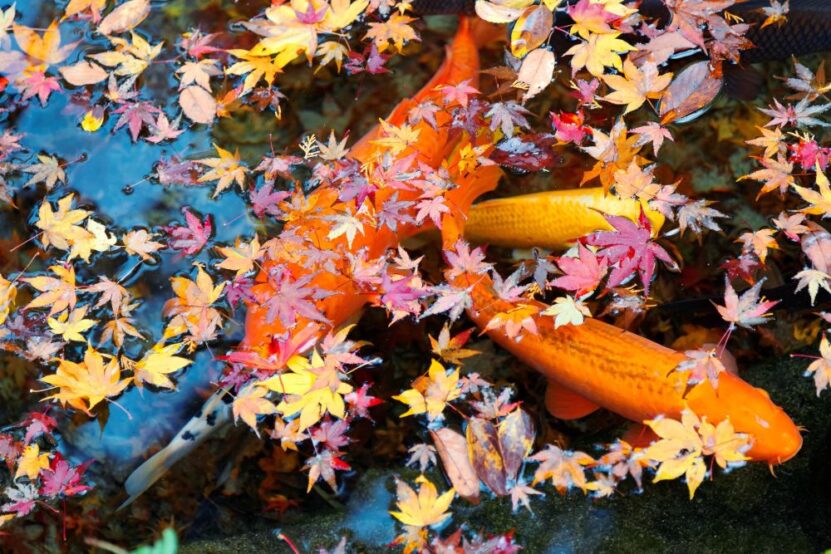
Warmer days mean increased activity. Fish swim frequently, feed aggressively, and grow rapidly. With metabolism in full gear, nutritional needs rise and water quality becomes more delicate.
Feeding Routines
Feed one to two times per day once water temperatures consistently remain above 55°F (13°C). Only offer as much food as fish will finish in five minutes. Excess food decays, creating ammonia spikes and fouling the water.
Stick to high-quality, protein-rich pellets designed for warm seasons. For ornamental species, occasional treats like dried shrimp or bloodworms can enhance coloration and vigor.
Oxygenation and Water Clarity
Hot weather reduces dissolved oxygen in the water. Fish may surface more often, gasping for air, especially during early mornings when oxygen is lowest. Aerators help maintain safe oxygen levels throughout the pond.
Essential steps include:
- Running aerators continuously during heatwaves
- Cleaning skimmers and biofilters to prevent clogging
- Adjusting water circulation for better flow
- Removing algae buildup that competes for oxygen
Predator Protection
Predators are most active during summer. Herons, raccoons, and neighborhood cats all take interest in visible fish. Protect your pond with strategies such as:
- Motion-activated sprinklers or noise deterrents
- Decoy predators like owls or herons
- Floating nets or partial covers
- Submerged fish caves or tunnels for hiding
Quick response and layered protection help prevent loss and stress among fish.
Autumn: Transition and Preparation for Winter
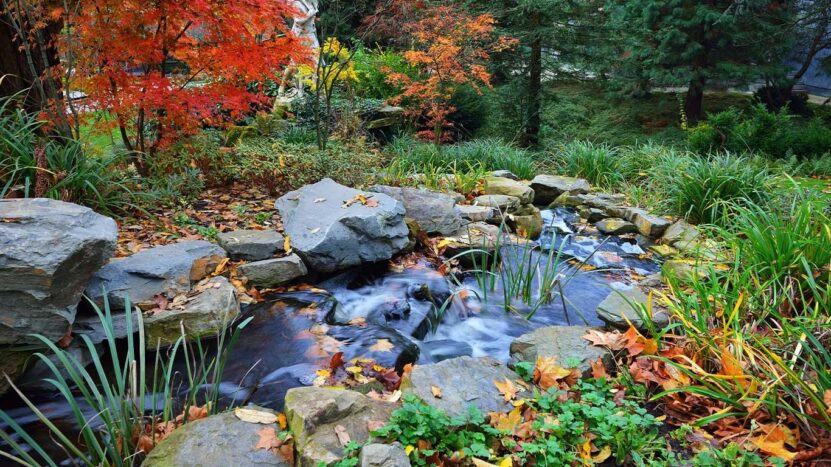
As temperatures begin to drop, fish instinctively reduce movement. This season bridges the energetic summer and dormant winter, requiring a shift in every aspect of care.
Feeding Adjustments
Cold slows digestion. Switch to lower-protein, wheatgerm-based food once water cools to 65°F (18°C). As it drops further toward 55°F (13°C), reduce feeding frequency.
By the time fish show little interest in food, daily meals should already have been scaled down. Eventually, feeding stops altogether once water falls below 50°F (10°C).
Pond Maintenance
Autumn cleanup is vital to reduce decomposition over winter. Accumulated waste can lead to poor water quality and oxygen depletion.
Actionable steps include:
- Installing netting over the pond to catch falling leaves
- Trimming back plants around the edge
- Removing dead foliage and other organic materia
- Cleaning filters without destroying beneficial bacteria
Environmental Balance
Avoid major chemical treatments during this time. Fish are slowing down, and stress tolerance is lower.
Allow the pond’s biological balance to stabilize naturally. Focus shifts toward minimizing disruption rather than stimulating growth.
Winter: Minimal Care, Maximum Vigilance
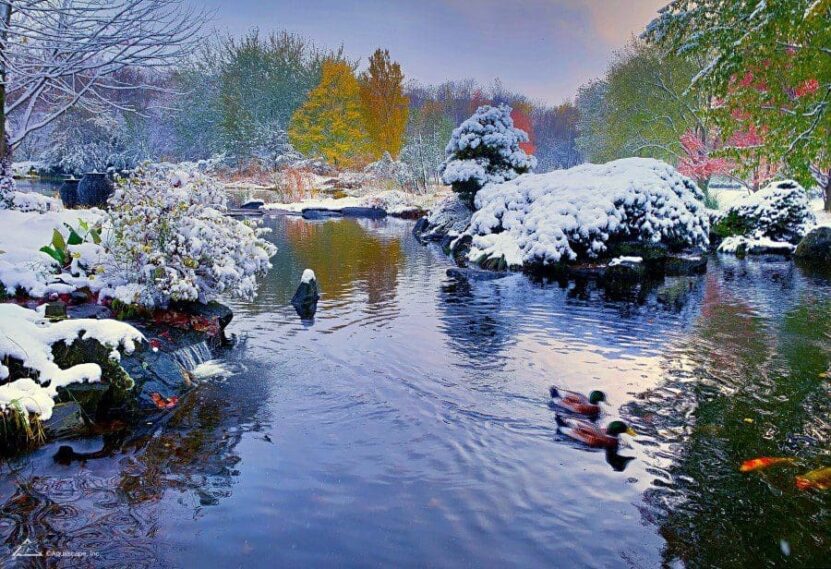
Winter brings dormancy. Fish settle at the bottom of the pond, conserve energy, and rely on internal reserves to survive. Their bodies become highly sensitive to disturbance, requiring less intervention but sharper observation.
Feeding Cessation
Once water temperature drops below 4°C (39°F), feeding must stop completely. Food left uneaten will rot and poison the water.
Fish in dormancy cannot digest, and attempting to feed them can cause internal damage or death.
They survive by slowing their metabolism and using stored energy, with occasional nibbling on algae or microorganisms if conditions allow.
Temperature Management
Monitor temperature consistently. Use a reliable pond thermometer. If ice forms over the surface, maintain an open breathing hole to allow gas exchange. Without ventilation, carbon dioxide builds up and fish can suffocate.
Helpful tools include:
- Floating deicers for spot thawing
- Aerators placed close to the surface
- Small water pumps that circulate just beneath the ice
System Maintenance
Keep pumps and filtration systems running if they are designed for winter use. Circulation ensures oxygenation and helps prevent full freezing. If not winter-rated, shut down equipment and remove it before damage occurs.
Maintenance remains light but critical. Every action should preserve oxygen, reduce stress, and avoid sudden changes that fish can’t handle during their most vulnerable phase.
Summary
Caring for pond fish throughout the year involves adjusting routines as the seasons shift. Feeding schedules, water quality, and behavior all demand careful observation.
Small actions, like switching foods, checking oxygen, or cleaning debris, contribute to long-term health. Consistent monitoring and response keep your pond stable through every change nature delivers.
Year-round attention leads to thriving fish and a visually satisfying pond ecosystem—no matter the season.
Related Posts:
- Winter Pond Care - Preventing Algae Growth in Cold Weather
- How Many Insurance Policies Can You Have at Once?…
- Website Development Costs for 2025 – What’s Changed…
- Revenue Growth Hacks for Small Businesses ─ Quick…
- Before the Storm Hits - What Your Gutters Know That…
- 10 Heart Attack Survivors in the Music Industry You…

